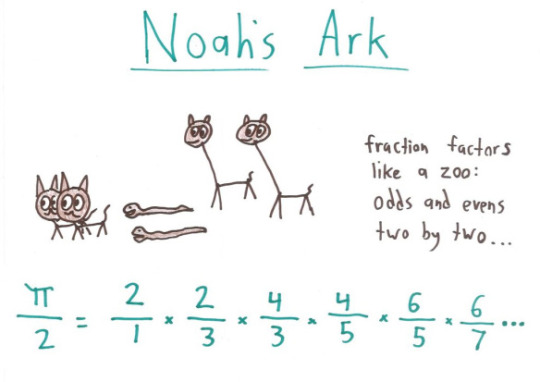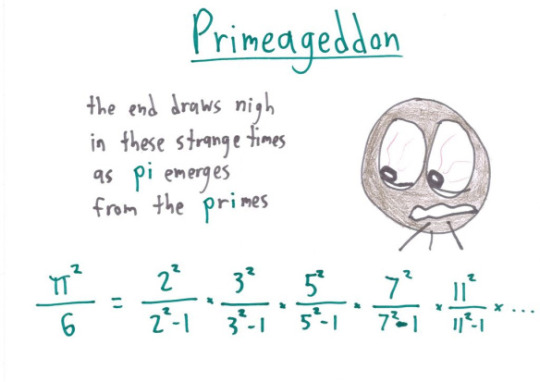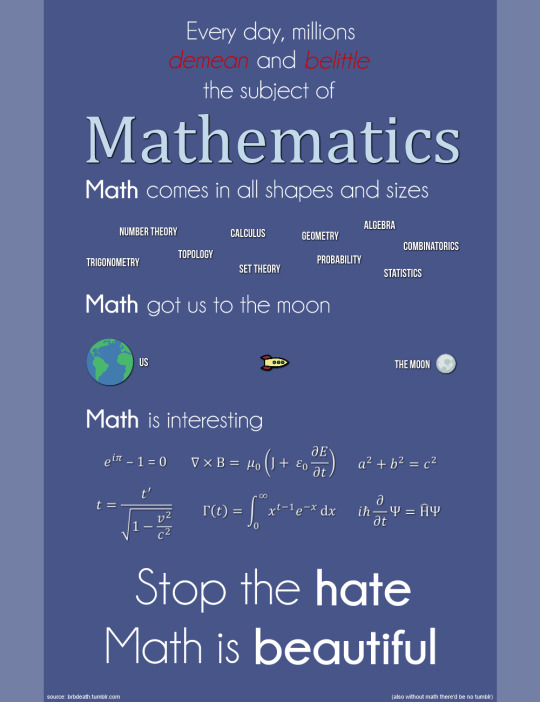Link
2 notes
·
View notes
Link
3 notes
·
View notes
Link
An amusing article by Math With Bad Drawings, exhibiting various π formulas.











936 notes
·
View notes
Text
When the team takes a look at the intern's code
/* by Thomas C */
73 notes
·
View notes
Photo

Pi in its full glory, popping up in all kinds of formulas.
Which one do you find the most beautiful or intriguing?
205 notes
·
View notes
Note
Do you know anything about the irrational number e (2.71828...)? Like its meaning in the nature? BTW I really enjoy your blog!
Hi nerdyyfun,
Since your question is quite general, I’ll give you some remarkable properties of Euler’s magical constant. First of all, its definition. In calculus, e is the unique real number so that the exponential function with base e equals its own derivative.

The exponential function is the only function with this property, except for the trivial constant zero function. You can thus figure out why it plays a central role in calculus.
Just like π, this number e pops up in various mathematical formulas.



Rather surprisingly, there is a strong connection between the exponential function and the sine and cosine. Their relation doesn’t show up immediately between the real numbers: you should look in the complex plane. The complex exponential function, complex sine and complex cosine (the unique extensions of the real-valued ones) are related as follows.

This intriguing identity is known as Euler’s identity. When you plug in the constant π, you get a formula which is commonly known as the most beautiful identity in whole mathematics:

This results make the exponential function (and the number e in particular) a nifty way for dealing with complex numbers, sines and cosines, and harmonic oscillations. The latter are very common in physics and nature. Indeed, differential equations governing harmonic oscillators are frequently solved by exponentials.
Another interpretation of the exponential function says that the rate of growth is proportional to the current size, which makes it a natural model for population growth (Malthus’ model).
However, there are also manifestations of e in nature which are more “visual”. In particular, the inverse function of the exponential, called the logarithmic function, can be transformed into a spiral using polar coordinates. This logarithmic spiral is very common in for instance seashells, because again, it models the idea that expansion is proportional to the current size, and thus expresses the (linear) growth between the animal and the proportional growth of its shell.

I hope you find this useful and interesting.Have a nice day, and thanks for the kind words!
106 notes
·
View notes
Link
0 notes
Photo

Mathematics brings people together :)
Paul Erdös was aged 72, Terence Tao only 10, and yet these two legendary mathematicians are discussing math problems together.
254 notes
·
View notes
Link
Se avete bisogno di trovare qualche immagine sul web, basterà eseguirete una semplice ricerca per soddisfare ogni vostra necessità . Quasi sicuramente approder
0 notes









